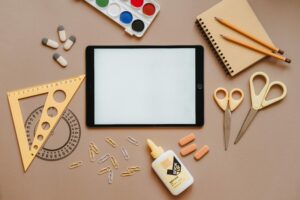My childhood was full of fast paced technological changes. I experienced the changes from:
- home phones to flip phones to smart phones
- VHS tapes to DVDs to streaming services
- box TVs to flat screens to projectors
- mailed letters to emails to text messages
- crank windows to automatic windows in cars
and so many more technological advancements that have occurred throughout the 21st century.
An Anthropological Introduction to YouTube
In the video above, Wesch discusses how technology and social media have provided a platform for higher amounts of media to be available. He points out that the larger volume and access to media encourages collaboration of knowledge and creativity. However, he explains that the most important element of media, is how it links people together and creates a community that was not previously possible.
Classrooms & Schools
The accessibility and use of technology and social media have changed classroom and school environments. As stated in the article, Teens, Social Media and Technology, teenagers are using technology and social media at higher rates than ever before. As well, the social media platforms being used by teenagers continues to shift towards Youtube and Tiktok which is different from what teens were using a decade ago. As stated in the lecture slides from this week: on average, children are 10.3 years old when they get their first phone and 11 years old when they sign up for their first social media account. Social media is not just present in high schools, but also in our elementary schools.
Some of the risks related to technology and social media include:
- cyber bulling
- influencer culture
- exploitation of minors
- fake news
- how algorithms curate media
- impacts of ai
What this means, is that as teachers, we need to engage students in learning opportunities that use technology to promote digital literacy. When students have digital literacy, they have a tool box to help keep them safe online. As teachers, we need to be aware of the media platforms our students are using to ensure that our school related instruction is relevant to their prior knowledge. As teachers, we also need to be mindful of the students we are teaching and their socio-economic positions. Families with lower household incomes are less likely to have access to smart phones, computers, and gaming consoles. This statistic directly impacts students that we teach, and therefore needs to be a factor in how we introduce technology in the classroom.
As technology continues to advance and be even more intertwined within our personal and professional lives, it is crucial that classrooms and schools are taking on the roll of teaching students digital literacy and how to engage with technology safely and meaningfully. This mindset and shift will help to prepare students more for their future success.

4 Comments
Carys Moffatt
Hey Kira! I love how you brushed up on those negative aspects like AI and fake news. Many people will bring subjects and ‘facts’ into a professional setting and will not know that their information is not credible. It is very important to teach students about fact checking and not believing everything they see on the internet without investigating further!
Alea Lehne
Hey Kira, I always enjoy your posts! You’re such a great writer, and everything flows so well and is so organized. Your titles are always so intriguing too! I love how you touch on how things used to be—I especially miss those huge box TVs that played VHS tapes; so many great memories. I also appreciate how you highlight the impacts of new technology, especially how it’s not always positive. My grandma keeps seeing AI-generated videos and thinks they’re real, which is pretty scary stuff!
Jasmine kaur
Hi Kira, This is such a thoughtful reflection on the evolution of technology and its impact on education! I completely agree that digital literacy is essential for students, especially as technology becomes more embedded in daily life.
The shift from traditional media to digital platforms has changed how students learn, communicate, and engage with the world. I love the idea of using technology meaningfully in the classroom while also being mindful of accessibility and socio-economic differences.
Chandre Lerat-Yew
It’s fascinating how much has changed in just a few decades, from basic communication tools like carrier pigeons to the interconnected digital world we live in now. I completely agree that teaching digital literacy is more important than ever. With the increasing use of technology in students’ lives, educators need to equip them with the skills to navigate both the opportunities and risks that come with it.